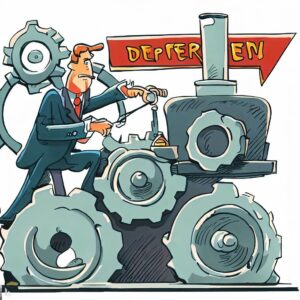How to improve production efficiency? As you may already aware production efficiency is a critical aspect of any successful business operation. Achieving optimal efficiency not only reduces costs but also maximizes output, enabling companies to meet customer demands and gain a competitive edge. If you’re wondering how to improve production efficiency, this comprehensive guide will outline ten proven strategies to help you streamline your processes and enhance overall productivity.
1 – Lean Manufacturing Techniques for Enhanced Efficiency
The implementation of lean manufacturing principles has proven to be a game-changer in terms of production efficiency. This approach focuses on eliminating waste, such as overproduction, excess inventory, and unnecessary transportation, allowing companies to optimize their operations and drive profitability.
One valuable resource that can guide organizations in their lean manufacturing journey is the Lean Enterprise Institute. Known for its expertise and reliability, this institute offers a wide range of comprehensive information, tools, and resources to support businesses in implementing lean manufacturing techniques effectively.
By adopting lean manufacturing principles, companies can experience several benefits. First and foremost, they can streamline their processes and reduce waste, resulting in cost savings and increased productivity. This approach also promotes a culture of continuous improvement, empowering employees to identify and solve problems, ultimately leading to greater job satisfaction and morale.
Moreover, the implementation of lean manufacturing techniques can enhance product quality. By eliminating non-value-added activities and focusing on meeting customer needs, companies are better positioned to deliver products that consistently meet or exceed customer expectations. This, in turn, can improve customer satisfaction, loyalty, and ultimately, competitiveness in the marketplace.
While lean manufacturing techniques can be complex to implement, the Lean Enterprise Institute offers valuable guidance and support. They provide detailed information on various lean tools, such as value stream mapping, Kanban systems, and 5S methodology, ensuring that companies have access to the necessary resources to enhance their efficiency and achieve their operational goals.
By incorporating lean manufacturing techniques into a company’s operations is vital for enhancing efficiency and optimizing productivity. Leveraging the expertise and resources provided by the Lean Enterprise Institute can significantly support organizations in successfully implementing these principles, ultimately leading to improved overall performance and long-term success.

2 – Continuous Improvement through Total Quality Management (TQM)
Continuous Improvement through Total Quality Management (TQM) is a proven and effective management approach that prioritizes the goal of attaining excellence in all aspects of a business. By emphasizing the importance of continuous improvement and customer satisfaction, TQM offers organizations a comprehensive framework to enhance their operational procedures and achieve long-term success.
TQM principles, which are advocated by the esteemed American Society for Quality, underscore the significance of employee involvement in the improvement process. By empowering employees, TQM encourages them to actively contribute to the organization’s growth and development. Moreover, TQM promotes data-driven decision-making, providing managers with valuable insights to make informed choices that drive improvement.
Another crucial aspect of TQM is the emphasis on streamlined processes. By reducing unnecessary steps and eliminating redundant activities, organizations utilizing TQM can improve production efficiency significantly. This streamlining leads to reduced costs, improved productivity, and quicker turnaround times. Additionally, TQM advocates for the adoption of best practices, which further contributes to enhanced efficiency and effectiveness.
A key advantage of implementing TQM practices is the direct impact on product quality. By focusing on continuous improvement, organizations can identify areas for enhancement and make necessary adjustments to ensure exceptional quality standards. This commitment to quality helps to establish a positive reputation in the market and build trust with customers.
Furthermore, TQM enables organizations to minimize defects and errors in their products and processes. Through a systematic and systematic approach to problem-solving, TQM helps identify the root causes of issues and implement corrective actions. As a result, organizations can significantly reduce defects, leading to fewer customer complaints, improved customer satisfaction, and increased loyalty.
By embracing the principles of Total Quality Management offers organizations a comprehensive framework to achieve continuous improvement and customer satisfaction. By involving employees, making data-driven decisions, streamlining processes, and emphasizing product quality, TQM drives organizations towards enhanced efficiency, reduced defects, and improved overall performance.

3 – Automation and Technology Integration
Integrating automation and technology into production processes has the potential to bring about a significant revolution in terms of efficiency. By automating tasks that are repetitive and time-consuming, companies can notably reduce human error, enhance speed, and ultimately boost overall productivity levels. In order to achieve such benefits, it is vital for businesses to thoroughly analyze their unique production requirements and diligently explore technological solutions that align with their industry.
When it comes to researching automation and technology, it is imperative to rely on credible sources that provide reliable information and insights. A prime example of such a source is Automation World, which offers valuable resources on the latest trends, cutting-edge technologies, and noteworthy case studies. By referring to resources like Automation World, businesses can stay informed and inspired throughout their automation journey.
Incorporating automation and technology into production processes can yield numerous advantages for companies. Firstly, automation minimizes the occurrence of human errors, as machines are capable of performing tasks with precision and consistency, eliminating the potential for mistakes due to fatigue or oversight. This enhanced accuracy translates into higher quality products and reduces the need for rework or corrective measures.
Additionally, automation significantly increases the speed and efficiency of production processes. Since machines can execute tasks at a faster pace compared to humans, businesses can reduce their cycle times and deliver products to their customers in a more timely manner. This allows companies to meet increasing customer demands, stay ahead of the competition, and potentially expand their market reach.
Moreover, automation brings forth a streamlined and optimized workflow. By automating repetitive tasks, companies can allocate their human workforce to more critical and value-added activities. This not only ensures that employees are engaged in fulfilling tasks but also enhances their job satisfaction and overall productivity. With the gradual elimination of manual and mundane tasks, employees are given the opportunity to engage in creativity, problem-solving, and innovation.
By incorporating automation and technology into production processes holds immense potential for companies to achieve significant efficiency improvements. By leveraging automation, businesses can mitigate human error, increase production speed, and enhance overall productivity. However, it is crucial for companies to analyze their specific production needs and seek out technological solutions that align with their industry. By referring to reliable resources such as Automation World, businesses can access invaluable insights and inspiration throughout their automation journey.

4 – Workforce Training and Skill Development
By allocating resources to comprehensive workforce training and skill development, companies can significantly enhance their production efficiency. This practice enables employees to acquire the essential abilities needed to execute their tasks with greater effectiveness. Trusted institutions such as the National Center for Biotechnology Information offer an abundance of research and guidelines that focus on strategies for enhancing workforce development, aiming to boost productivity and overall efficiency.
The importance of investing in workforce training and skill development cannot be overstated. With the rapid advancements in technology and evolving industry trends, staying ahead of the curve is crucial for a company’s success. Through ongoing training programs, employees can expand their knowledge and acquire new skills that will not only benefit themselves but also contribute to the growth and prosperity of their organization.
Moreover, comprehensive training initiatives have a positive impact on employee morale and job satisfaction. When employees feel valued and supported through professional development opportunities, they are more likely to be engaged and motivated. This, in turn, leads to higher job performance, improved productivity, and ultimately, a more prosperous business.
Furthermore, comprehensive workforce training and skill development initiatives foster a culture of continuous learning within the organization. By encouraging employees to continually build their skills and knowledge, companies can create a dynamic and adaptable workforce capable of successfully navigating any challenges that arise. This adaptability is crucial in today’s competitive business landscape, where organizations must be flexible and responsive to ever-changing market conditions.
Investing in comprehensive workforce training and skill development is a vital aspect of improving production efficiency and overall success. By equipping employees with the necessary competencies, companies can enhance their productivity, boost employee morale, and foster a culture of continuous learning. Ultimately, this investment will lead to a more efficient, adaptable, and successful organization.

5 – Effective Supply Chain Management
Improving supply chain management is crucial for enhancing production efficiency. By streamlining this process, businesses can witness significant positive impacts. Therefore, it is essential to establish strong relationships with suppliers, implement just-in-time (JIT) inventory management, and optimize logistics operations. These strategies enable organizations to minimize delays, decrease costs, and expedite the overall production process.
Companies can access vital resources and gain insightful knowledge about supply chain management strategies from the Council of Supply Chain Management Professionals. This reputable organization offers a wealth of valuable information and guidance on optimizing efficiency within the supply chain. By leveraging their expertise, businesses can gain a competitive advantage in the marketplace.
One key area to focus on is building strong relationships with suppliers. Maintaining open lines of communication and collaborating closely with suppliers fosters mutual trust and understanding. It also allows businesses to negotiate favorable terms, such as discounts or faster delivery options, both of which contribute to improved efficiency. Regular and effective communication with suppliers ensures that both parties are aligned on expectations and goals, reducing the chances of misunderstandings or unmet demands.
Implementing just-in-time (JIT) inventory management is another effective approach. By minimizing excess inventory and closely monitoring customer demand, organizations can precisely match supply to demand. This approach reduces the risk of excess inventory becoming obsolete or tying up valuable resources. Moreover, JIT inventory management minimizes storage costs and allows for quicker order fulfillment, leading to improved overall efficiency.
Optimizing logistics operations is equally vital. By utilizing technology and data analytics, businesses can track shipments, identify potential bottlenecks, and implement corrective measures. Effective logistics optimization ensures that goods are transported swiftly, minimizing delays and maintaining tight control over the entire supply chain.
By incorporating these strategies, businesses can achieve a streamlined supply chain management process. This holistic approach to optimizing efficiency ultimately leads to enhanced production output, reduced costs, and improved customer satisfaction. Thus, investing time and resources in supply chain management is a wise decision for any organization striving to thrive in today’s competitive marketplace.

6 – Implementing Performance Metrics and Key Performance Indicators (KPIs)
In order to enhance productivity and optimize production efficiency, it is crucial to implement performance metrics and Key Performance Indicators (KPIs). These tools allow companies to measure their performance and make data-driven decisions for continuous improvement. By utilizing KPIs such as Overall Equipment Effectiveness (OEE), cycle time, and scrap/rework rates, organizations can identify areas of opportunity, monitor progress, and take proactive actions to enhance their operations.
To facilitate the implementation of performance metrics and KPIs, the United States Office of Personnel Management offers comprehensive guidelines. These guidelines provide a clear framework for developing and implementing performance measurement systems that target organizational efficiency improvement. By following these guidelines, businesses can ensure that their metrics and KPIs align with their strategic objectives and provide actionable insights.
The adoption of performance metrics and KPIs enables organizations to identify bottlenecks and inefficiencies that hinder their productivity. For example, OEE can help companies gauge how effectively their equipment is being utilized and identify areas where improvements can be made. Cycle time measurement allows organizations to assess the time taken to complete a specific task or process and identify any delays or opportunities for streamlining. By tracking scrap/rework rates, businesses can identify quality issues and take steps to minimize waste, improve processes, and enhance customer satisfaction.
Overall, implementing performance metrics and KPIs is an essential practice for organizations looking to optimize their production efficiency. By leveraging these tools, companies can measure their progress, identify areas for improvement, and make informed decisions based on reliable data. The guidelines provided by the U.S. Office of Personnel Management offer valuable advice and best practices to ensure the successful implementation of these performance measurement strategies.

7 – Implementing Cross-Functional Collaboration
Implementing cross-functional collaboration is a crucial step towards improving production efficiency. By breaking down the barriers between departments and encouraging open communication and teamwork, organizations can foster a culture of knowledge sharing and problem-solving. This approach allows for a more efficient resolution of bottlenecks, resulting in enhanced overall productivity.
To support this endeavor, it can be highly beneficial to explore the extensive collection of articles on collaboration and teamwork offered by Harvard Business Review. These resources provide valuable insights and strategies that can facilitate the establishment of effective cross-functional collaboration within your organization.
One key advantage of implementing cross-functional collaboration is the breakdown of silos. These divisions between departments often hinder communication and collaboration, leading to information hoarding and potential bottlenecks. However, by promoting open communication channels and encouraging teamwork across departments, organizations can create an environment that encourages knowledge sharing and collaboration.
Collaboration across functional areas also enables a more efficient resolution of bottlenecks. When teams from various departments collaborate, they bring different perspectives, expertise, and approaches to problem-solving. This diversity allows for the identification and resolution of issues from multiple angles, increasing the probability of finding effective solutions faster.
Moreover, cross-functional collaboration has the potential to generate innovative ideas and creative solutions. By bringing together individuals with different backgrounds, skills, and experiences, organizations can harness the power of diversity to drive innovation. This collaboration fosters an environment where new ideas can emerge and be developed into effective strategies.
By implementing cross-functional collaboration is a key strategy for organizations looking to enhance production efficiency. By breaking down silos, encouraging open communication, and promoting teamwork across departments, organizations can foster knowledge sharing, resolve bottlenecks efficiently, and drive innovation. The extensive collection of articles on collaboration and teamwork offered by Harvard Business Review can provide valuable insights and strategies to support this process.

8 – Continuous Monitoring and Maintenance
Continuous monitoring and maintenance play a vital role in the prevention of breakdowns and production delays. By utilizing predictive maintenance techniques, employing condition monitoring technology, and scheduling routine equipment inspections, unexpected downtime can be minimized, and overall productivity can be optimized.
Predictive maintenance involves the use of advanced data analytics to forecast potential equipment failures before they occur. By analyzing historical data and real-time information, maintenance professionals can identify patterns and signs of equipment degradation or malfunctioning. This allows them to perform targeted maintenance tasks before a breakdown happens. Additionally, employing condition monitoring technology enables the continuous monitoring of equipment performance, allowing for early detection of any abnormalities or deviations from normal operating conditions. By promptly identifying these issues, appropriate maintenance actions can be taken to prevent the progression of problems that could lead to downtime or reduced productivity.
Implementing a well-structured equipment inspection schedule is also crucial. Regular inspections allow for the identification of potential issues, such as worn-out parts or inadequate lubrication, before they escalate into more significant problems. By adhering to a routine inspection schedule, organizations can ensure that their equipment is in optimal condition and avoid any unexpected breakdowns or production delays.
To further improve production efficiency, organizations can refer to the National Institute of Standards and Technology’s information on equipment maintenance best practices. This valuable resource provides guidance and recommendations on strategies and techniques for effective equipment maintenance. By following these best practices, organizations can enhance their maintenance processes and ultimately achieve higher levels of production efficiency.
By continuous monitoring and maintenance, including the adoption of predictive maintenance techniques, the use of condition monitoring technology, and the implementation of routine equipment inspections, are essential for minimizing breakdowns, preventing production delays, and optimizing overall productivity. The NIST’s equipment maintenance best practices serve as a valuable guide for organizations seeking to improve their production efficiency.

9 – Efficient Workflow Design and Layout Optimization
Efficient workflow design and layout optimization are crucial elements in maximizing productivity and reducing unnecessary waste in your production processes. By carefully analyzing workflow patterns and employing process mapping techniques, you can identify areas of improvement and streamline your operations.
One effective way to enhance efficiency is by rearranging machinery to facilitate a smoother flow of materials and minimize unnecessary movement. This could involve strategically placing equipment and workstations to reduce the distance traveled during production or ensuring that the layout supports a logical sequence of tasks. By optimizing the utilization of space and resources, you can significantly reduce time wastage and increase overall productivity.
To further support your efforts, you can explore the valuable resources and case studies provided by the Manufacturing Extension Partnership. This organization offers practical insights and real-world examples of successful workflow designs to inspire and guide your own improvements. By learning from the experiences of others, you can gain valuable knowledge and avoid common pitfalls, ultimately accelerating your own implementation process.
Implementing efficient workflow design and layout optimization can yield numerous benefits for your organization. Not only will it improve productivity and reduce waste, but it can also enhance employee morale and satisfaction. A well-designed and optimized workflow eliminates unnecessary steps and frustrations, allowing your team to focus on value-added tasks and contribute to the overall success of your operations.
Optimizing the layout and design of your production workflow is a critical step towards achieving operational excellence and maximizing efficiency. With process mapping techniques, collaborative analysis, and resources like those provided by the Manufacturing Extension Partnership, you can inspire and implement significant improvements in your organization. By continuously evaluating and refining your workflow design, you can stay ahead of the competition and elevate your business to new heights.

10 – Continuous Employee Engagement and Communication
Continuous employee engagement and communication play a pivotal role in cultivating a motivated and highly productive workforce. It is vital for organizations to actively seek feedback, acknowledge achievements, and empower employees to participate in decision-making processes as these initiatives can greatly enhance overall morale, productivity, and production efficiency.
Recognizing the significance of employee engagement, the Society for Industrial and Organizational Psychology provides comprehensive resources and publications that offer invaluable insights into implementing effective strategies to optimize organizational performance through employee engagement.
In today’s competitive business landscape, companies must prioritize engaging their employees on a continuous basis. By creating an environment that encourages open communication, organizations foster a sense of belonging, involvement, and collaboration among their workforce. Regularly seeking feedback from employees not only demonstrates that their opinions are valued, but also provides valuable insights that can contribute to continuous improvement within the organization.
Moreover, recognizing and celebrating employee achievements is a powerful way to boost morale and motivation. This can be achieved by implementing recognition programs, such as employee of the month awards or team-wide acknowledgments for outstanding accomplishments. By acknowledging and rewarding employees for their hard work and dedication, organizations create a positive work culture that inspires individuals to exceed expectations.
Furthermore, involving employees in decision-making processes enhances their sense of ownership and empowerment. When employees are given opportunities to contribute their ideas and perspectives, they feel valued and are more likely to be invested in the company’s success. This not only leads to better decision outcomes, but also fosters a sense of trust and loyalty between management and employees.
To optimize employee engagement, organizations should leverage the resources and publications offered by the Society for Industrial and Organizational Psychology (siop.org). These resources provide evidence-based strategies, case studies, and best practices that can guide organizations in cultivating a highly engaged and motivated workforce.
Continuous employee engagement and communication are crucial for organizations aiming to maintain a motivated and productive workforce. By prioritizing open communication, seeking feedback, recognizing achievements, and including employees in decision-making processes, organizations can enhance morale, productivity, and overall production efficiency. The Society for Industrial and Organizational Psychology is a valuable resource that provides comprehensive guidance on implementing effective employee engagement strategies to drive optimal organizational performance.

Conclusion
Improving production efficiency is a multifaceted task that requires a comprehensive approach. By implementing lean manufacturing techniques, adopting automation, focusing on continuous improvement, and optimizing various aspects of your operations, you can achieve significant gains in efficiency. Remember that successful implementation may require tailoring strategies to your specific industry and business needs. By continuously monitoring, evaluating, and adapting your approaches, you can maintain a competitive advantage and propel your business towards sustained success.
